The value proposition is probably the most important part of a SaaS product’s marketing strategy.
Why?
Because it has to do two things: grab the potential customer’s attention and convince them to sign up (highlight your competitive advantage).
The main reason people (read: prospects) are not signing on the dotted line and giving their credit card information to SaaS vendors is because they can’t really understand how much value these products or services can bring to their businesses.
That’s why the best SaaS value propositions focus on customers’ benefits. They showcase:
- who you intend to service
- what you do
- what makes you different from other SaaS brands in your vertical
The aim is to identify and incorporate every value proposition-related ingredient and present them in a precise, pithy manner.
Keeping this in mind, we scoured the internet and talked to experts to discover some of the best SaaS value proposition examples. Today, we will dissect these examples to see what makes them a good value proposition and how to attract potential customers.
Here are the nine best SaaS value proposition examples to learn from:
1. Webflow
“The site you want — without the dev time / Your website should be a marketing asset, not an engineering challenge.”
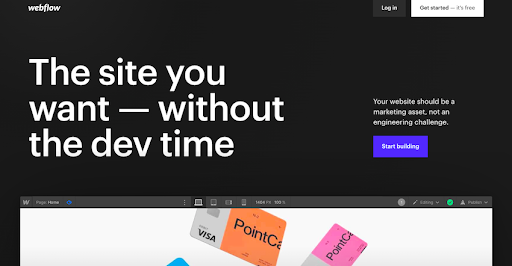
With Webflow, you can design a site for any device without touching a line of code. They eliminate the headache associated with coding and maintenance, allowing you to focus on the marketing side of things.
Webflow’s value proposition highlights all these features succinctly. Even if you’re unfamiliar with the brand, you would know right away – through their value proposition statement – what benefits you can derive from the tool.
As an added bonus, they support their value proposition with the subheading. It brings visitors’ attention to the solution they’re providing – and the “engineering challenge” they’re addressing.
A testament to the sway of Webflow’s messaging, their great value proposition attracted SelectSoftware Reviews founder Phil Strazzulla to delve into the software originally and turned him into a customer.
According to Phil,
“Webflow is a fairly new platform that allows anyone to build a customized website without having to learn HTML, CSS, or Javascript.
Their value proposition is “The site you want — without the dev time,” which perfectly fits their main functionalities. While we did a lot more diligence before deciding to move forward with this platform over WordPress, this messaging is what pulled us in originally.
Beyond the value proposition, their blogs/videos/webinars/etc. all align with this north star of allowing you to build the site you want without the need to learn to code.”
2. Hubstaff
Spend less time tracking and more time growing. / The all-in-one work time tracker for managing field or remote teams.
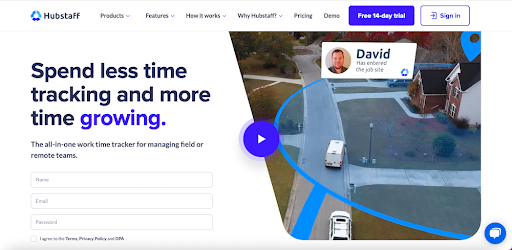
Hubstaff is an all-in-one work time tracker for managing field or remote teams, which is basically their sub-headline. You read it, and you’ll get a good grasp of their functions the first time.
The main value proposition is also crisp and straightforward. It directly relays how the tool will solve target customers’ predicament (spend less time tracking) and how it will benefit them (more time growing).
Then they have a well-produced video demonstrating how their product solves the problem. If the value proposition statement and the sub-headline don’t do the job, the accompanying video will do the rest to sway Hubstaff’s target audience.
3. Asana
Work on big ideas, without the busywork. / From the small stuff to the big picture, Asana organizes work, so teams know what to do, why it matters, and how to get it done.
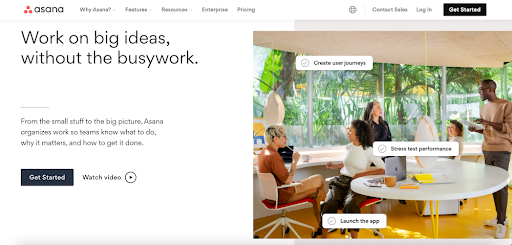
Asana’s value proposition is a lot like Hubstaff’s.
The main value proposition states what the customers will get from the product (work on big ideas) and the problem they’re eliminating (the busy work).
If it sounds vague initially, Asana does an excellent job of elucidating the point with a descriptive – yet concise – sub-header. The inclusion of “from the small stuff to the big picture” puts light on the audience they’re targeting, which is businesses of all sizes, in this case.
To offer more perspective, Asana tops it off with pictorial depictions of teams in action, coupled with sprinkling benefits all over the picture.
4. AccuRanker
Rank Tracking & SERP Analytics For SEO Professionals / 14 days free trial – no credit card needed
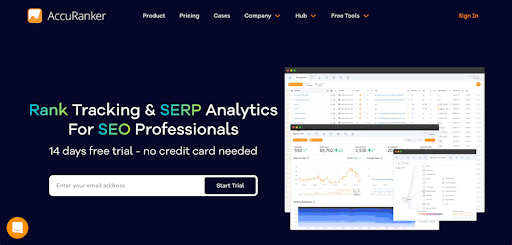
The ultimate goal of any value proposition is to communicate the benefits your customers will receive when dealing with you. AccuRanker does it by simply pointing out its benefits.
You know right away:
- What do they do for their intended audience? Rank tracking and SERP analysis
- Their target audience? SEO Professionals
It also shows you don’t always have to string together a sentence with witty phrases or flowery prose to entice the visitor – especially when the basics work so well.
The introductory statement is sufficient to get the point across without overwhelming the reader with too much information.
As such, AccuRanker doesn’t need a sub-header to expound on the main value proposition. Instead, they use the sub-heading astutely to mention their generous offer of a “14-day free trial – no credit card needed.”
The visual representation of their tool is like a proverbial cherry on top.
5. ProofHub
The one place for all your projects and team collaboration
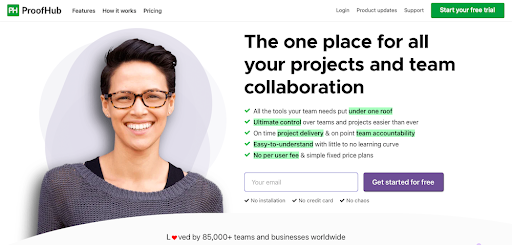
There’s an allure to catchy phrases and over-the-top promises that incite us to click and read further.
Unfortunately, these tactics don’t always lead to clear value propositions. After all, what you do best is very important to your business, and if you can’t convey it in an easy-to-follow manner to your ideal customer, then who will want to listen anyway?
ProofHub understands this, which is apparent from its value proposition. It’s basically a description of their product, distilled down to one sentence – “the one place for all your projects and team collaboration.”
They double down using bullet points to put forward all the benefits and differentiating factors of the product with greater clarity.
We also got the chance to talk to ProofHub’s team. According to Vartika Kashyap, CMO at ProofHub,
“I believe having a clear value proposition is much more important than an enticing one. It’s shaped according to your brand’s market position, your core USP, and the exact pain point you’re addressing.
In our internal experiments, we have found an educative and direct copy to perform better than a catchy copy in terms of the value proposition.”
6. CleanShot X
Capture your Mac’s screen like a pro.
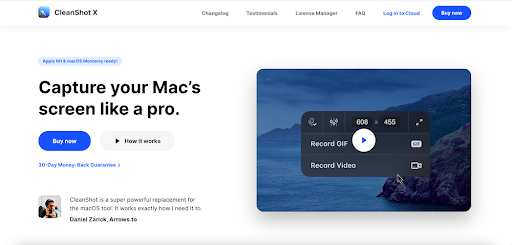
If you weren’t aware, you have 5 to 30 seconds to hold your visitors’ attention.
And your value proposition is the first thing customers will see. That’s why it’s essential to develop a value proposition that makes your business stand out on the market, relays all the benefits of your products, and is succinct at the same time.
CleanShot’s value proposition ticks all the boxes.
It’s only seven words long. And as soon as you land on their homepage, you know:
- What the brand does (capture Mac’s screen)
- Who their target audience is (Macbook users)
- What makes them different from their counterparts (the ability to take screenshots like a professional)
The combination of the video demonstrating the product’s benefits in action makes for a near-perfect value proposition.
7. WeInvoice
The Best Invoicing Software That Makes Online Invoice Simple
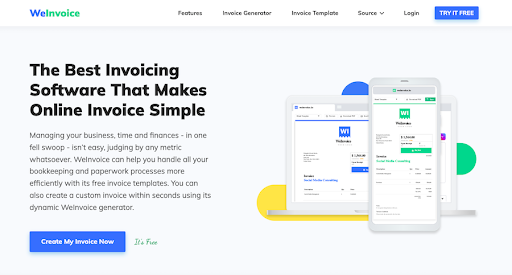
WeInvoice’s value proposition shares several similarities with other examples on this list.
Snappy and to the point? Check.
Sub-header to elaborate on the benefits? Check.
Differentiating factor (making online invoices simple)? Check
Supported by visual demonstration? Check.
That said, the sub-header could be shorter or distilled into bullet points. Although, the clever use of power words like “free” is commendable.
Furthermore, the call to action (CTA) button emphasizes the free signup, which is again important to entice customers in the face of competition.
And the team at WeInvoice did see positive results – an increase of 11% in their client engagement rates – after overhauling their value proposition last year.
Here is Alex Bryce’s, WeInvoice co-founder, take on their approach to creating the value proposition and positive results they received after the overhaul,
“The best value proposition can be considered meticulous and concise, clearly defining what the brand offers. Moreover, it must be written in the everyday language of the target audience to explain how your product/service relieves their pain point.
Last year, we created a value proposition for our online marketing messaging using the above criteria. When we performed our latest audit in December, we found that our customer and client engagement rates have increased by 11% after adopting the said value proposition.”
8. ClickUp
One app to replace them all. / All of your work in one place: Tasks, Docs, Chat, Goals, & more.
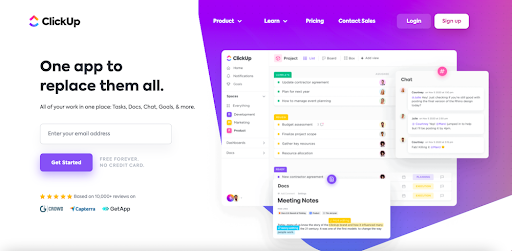
ClickUp’s short and straightforward value proposition effectively tells what they do – they provide a workspace to replace them all.
The sub-header has the answer if you’re not privy to what ClickUp does.
ClickUp houses all of your work in one place, eliminating the need to use separate apps for managing tasks, docs, goals, chats, and more.
Another subtle message this value proposition passes along is the idea of ‘cost savings.’ Having all your work in one place and eliminating the need for several apps means you get to save a ton of money.
The CTA also makes it clear that when you get started, you’ll be able to use ClickUp for free forever.
It doesn’t get better than that. But in ClickUp’s case, it does. They double down with a visual depiction of their workspace – showing that ClickUp indeed walks the talk.
9. Shopify
The platform commerce is built on / Millions of the world’s most successful brands trust Shopify to sell, ship, and process payments anywhere.
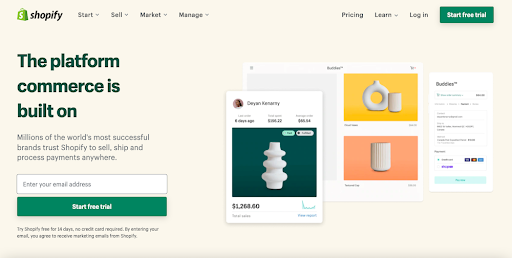
Shopify’s value proposition summarizes what makes people gravitate towards them – it’s the place to be if you want to build your ecommerce store.
The sub-header statement “millions of world’s most successful brands trust Shopify…” does the job of assuring potential customers that they’re in the right company.
It further states what they get out of the platform, that is, the ability to sell, ship, and process payments anywhere.
To back it up, their homepage, along with other landing pages, display examples of ecommerce stores. They help you visualize your own store that Shopify can help you build.
What a value proposition consists of
Your value proposition is the single most important factor in defining your product’s identity.
If it doesn’t accurately portray what it is you do, why your product/service is a relevant solution for your customer, and why people should care about that solution, then you are shooting yourself in the foot before you’ve even started.
Consider these elements while putting together a winning value proposition:
- Headline – It can make or break a customer’s impression of your business, product, or service. Your goal is to build trust, increase relevance to the user’s needs, and drive action.
- Sub-headline – Here, you’ll elaborate on the headline and tell what you do, for whom, and how it benefits them.
- Bullet points (not necessary) – List your key benefits here.
- Visual – Adding visuals is an important value proposition element. You need to be able to show your site visitors what you do without relying on them reading blocks of text.
Headline, Sub-headline, and Visual. These are the primary elements you want to include in any value proposition you create. Craft these elements strategically while taking into account your core conversion goal and the particular marketplace in which you operate.
The anatomy of a good value proposition for a SaaS business
Although these SaaS companies have different functions and products, their value propositions feature some similar patterns.
They all avoid flowery, self-righteous dross of corporate speak like a plague. Instead, the focus is on relaying how it will solve customer problems. This is because a great value proposition also aids in customer retention.
While these value propositions won’t suddenly propel your customers into the world of magic and mysticism – they do something much better. They communicate:
- Benefits your product offers to customers
- Value your product brings
- Who your target customer is
- How are you different
Simply put, a value proposition should be a simple but detailed explanation of how a product will solve customers’ problems and what advantages it has over its competitors.
Here’s everything to consider while creating your value proposition:
- Value propositions encompass the benefits to customers, not just the features.
- Your messaging should be tailored to your audience.
- Avoid using buzzwords in your value proposition (these words are overused and unlikely to resonate).
- Include a trial period in your sell sheet if possible. (Make sure you have something of immediate value that customers can access as soon as they sign up for a free trial).
- Keep it real and on-brand with images that reflect what your company is about.
- Save the long-term vision for later in your free trial templates, where you want to create anticipation and a need for future purchases.
- Don’t overwhelm the reader with too much information.
Mark Whitman, the founder of the content marketing agency Contentellect, also suggests,
“Write as if you’re describing the product or explaining the topic to a friend. Avoid being too technical. But if you need to be technical, make sure to explain it in simpler terms for the reader’s benefit.
Writing a good introduction is also critical. The client and the reader will always read the introduction, so it needs to hook them in and impress them. Don’t waffle; get to the point.”
Are you ready to write your perfect value proposition?
Hopefully, these examples will give you some nuts and bolts to create your own value proposition. Formulate who you are and how your product fits into the problem.
A strong value proposition is not written on a whim but requires careful consideration as it is the foundation upon which everything else rests. It develops an emotional connection with the buyer, allowing them to visualize what their lives will be like after they have purchased from you.
You now have a solid understanding of what makes a good value proposition. Keep it in mind as you develop your own, and do not be discouraged by the process.



